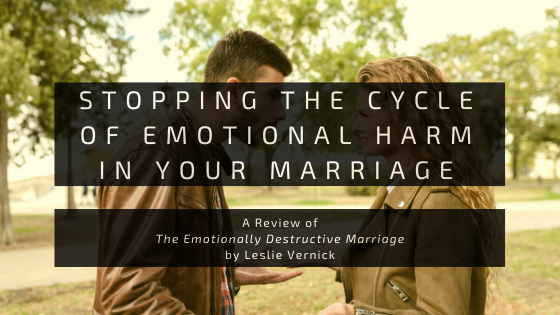What does it mean to be in an emotionally destructive marriage? Have you felt coerced into doing things you don’t want to do? Do you hear name-calling or contemptuous criticism when your spouse doesn’t like your choices? Do your spouse’s words lead you to feel horrible about yourself?
These are common symptoms of emotional abuse or harm. Others include a crippling sense of self-doubt based on your spouse’s criticism and feeling terrified of his or her rages. Gaslighting is common: when you attempt to directly address an issue with your spouse, you consistently leave the conversation feeling as though it was all your fault.
Leslie Vernick’s book The Emotionally Destructive Marriage gives a message of relief to women who experience their husband’s emotional and verbal abuse but feel trapped and unable to change anything about it. In this book, Vernick outlines the characteristics of an emotionally destructive marriage and explores what that type of abuse feels and looks like. She also shatters the myths of distorted Christian teachings that cause women to doubt their experience based on overly simplistic views of women’s roles.
Since this book comes from an explicitly Christian perspective, including prayers at the end of each chapter and a focus on Biblical truths, it may initially alienate someone who doesn’t have the same faith background. Regardless, I believe the practical tools and helpful insight she provides can be beneficial for any woman who is concerned about the state of her marriage.
Helpful Insights from This Book
An Understanding of Emotionally Destructive Marriages
Early on in the book, Vernick describes emotionally destructive marriages and gives assessments to help you identify the difference between an abusive relationship and an unsatisfying relationship. This distinction between dissatisfaction in marriage and being the recipient of emotional abuse or manipulation can be validating to women who have been told they are simply unhappy in their marriages and they need to change their own perspective.
A Shift in Perspective on Biblical Submission
Unfortunately, many Christian women have been taught messages about the role of submission to their husbands without a full understanding of what this word means and what it requires of the husband. Submission is not blindly going along with whatever the husband wants, particularly when the husband is asking the wife to do something she knows is wrong or will be harmful to herself or others. Looking at the way Jesus led others, it is clear that leadership means serving and looking out for the needs of those you lead more so than your own needs. Submission cannot be forced or demanded, and it is not meant to be a power play of cruelty. If you experience “submission” as a weapon in your marriage, you are likely in an emotionally destructive marriage.
Validation of a Woman’s Choice
Vernick allows her readers to make a choice about the future of their marriage: whether they want to stay together, separate, or divorce. She doesn’t dictate what that choice should be: instead, she encourages women that whatever they choose to do, they do it “well.” Recognizing that each situation is different and there is no one solution for everyone, she gives practical help for whichever option you choose. She warns against people who claim simple solutions for such a complex issue, reinforcing that what is right for one woman and marriage may not be right for another.
If you are in an emotionally destructive marriage, you likely are not given opportunities to make your own decisions. You are told what to do by your spouse and haven’t had much space to explore what you truly want. Often gaslighting contributes to this, as emotional manipulation can lead you to believe your desires are different from what they truly are. She encourages you to get in touch with your own desires as part of this discerning process.
Practical Tools and Next Steps
At the end of each chapter in the book, Vernick gives specific action steps to help you explore changes you can make to move out of feeling stuck in your marriage. At several points through the book, she refers the reader to her website for resources to download that help you begin to set boundaries in your marriage. She has video resources available for both spouses to understand the dynamics of the emotionally destructive marriage.
Challenges Toward Growth
Vernick knows her audience: the wife in the emotionally destructive relationship is probably the one reading this book, not the husband. She also knows that many of these women want to change their spouse, but they have little to no control over that change. Instead, she challenges women to do their own work: becoming more confident and supported so that they can take steps toward healing. At one point she discusses her intentional decision to refrain from talking about reasons for husbands to become emotionally abusive: to her, it doesn’t matter how it happened, but instead that it is happening, and the wife needs to respond to protect herself and her family.
For Partners of Sex and Love Addicts
When I’m working with partners of sex and love addicts, I see the devastation that trauma causes and how it can limit a woman’s sense of personal power. It is important to allow the husband to carry the blame for stepping out on the marriage. And it is incredibly important for your own healing to recognize how these actions have affected you and how you may be responding negatively in your own way as a result. Taking ownership over your own response can help you regain a personal sense of power. Acknowledge the reality of the trauma you’re experiencing, but also acknowledge steps you can take to regain control over your own choices and life.
Practicing Self-Care
Healing from the trauma of an emotionally abusive marriage requires taking care of yourself and processing your own past hurt that may be contributing to your response. Practice self-care by getting in touch with your own needs, which probably have been hidden because you’ve been focused on appeasing your spouse. Find support through trusted friends, therapy, and support groups: you cannot do this alone. Learn to communicate boundaries with your spouse and say “no” when you feel uncomfortable. The best way to do this work is to get into your own therapy to explore how your actions has been affected by your upbringing and past trauma such that you respond in the unique, particular way you do.
How to Communicate with an Emotionally Destructive Spouse
There often comes a time where direct communication needs to happen with your spouse in order to open the door for change. Vernick suggest templates for how to talk about what you’re willing and not willing to tolerate, emphasizing the need for follow-through on what you commit to do in response to his intolerable behaviors. She reminds you not to get sucked in to the emotional abuse or manipulation, remaining calm as a way of avoiding destructive dynamics from the past. She encourages keeping yourself safe as the highest priority, suggesting this confrontation happen in public and with support individuals nearby. These practical tips help this process feel more manageable.
If you are wondering if you might be in an emotionally abusive or destructive marriage, pick up this book and give it a read. Do the assessments and follow the action plans. Learn to communicate clearly and directly with the specific and practical steps Vernick offers. Open yourself up to explore your own history and how it might be influencing your spouse to your spouse. My hope is that this will give you the courage you need to take a stand and take up space in your marriage.








